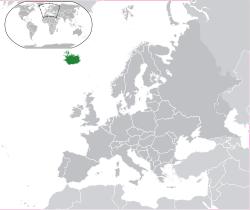|
|
|
|
|
|
|
|
|
|
|
|
Iceland
 Location of Iceland.
Location of Iceland.It has a population of about 320,000 and a total area of 103,000 km². Its capital and largest city is Reykjavík, whose surrounding area is home to some two-thirds of the national population. Located on the Mid-Atlantic Ridge, Iceland is volcanically and geologically active on a large scale; this defines the landscape. The interior mainly consists of a plateau characterised by sand fields, mountains and glaciers, while many big glacial rivers flow to the sea through the lowlands. Warmed by the Gulf Stream, Iceland has a temperate climate relative to its latitude and provides a habitable environment and nature. According to Landnámabók, the settlement of Iceland began in AD 874 when the Norwegian chieftain Ingólfur Arnarson became the first permanent Norwegian settler on the island. Others had visited the island earlier and stayed over winter. Over the next centuries, people of Nordic and Celtic origin settled in Iceland. Until the 20th century, the Icelandic population relied largely on fisheries and agriculture, and was from 1262 to 1918 a part of the Norwegian, and later the Danish monarchies. In the 20th century, Iceland's economy and welfare system developed quickly, and in recent decades the nation has implemented free trade in the European Economic Area, diversifying from fishing to new economic fields in services, finance and various industries. Iceland is a free market economy with low taxes compared with other OECD countries. The country maintains a Nordic welfare system providing universal health care and post-secondary education for its citizens. Icelandic culture is based on the nation’s Norse heritage and its status as a developed and technologically advanced society. The country's cultural heritage includes traditional Icelandic cuisine, the nation’s poetry, and the medieval Icelandic Sagas. In recent years, Iceland has been one of the wealthiest and most developed nations in the world. In 2007, it was ranked as the most developed country in the world by the United Nations' Human Development Index and the fourth most productive country per capita. In 2008, however, the nation’s banking system systematically failed, causing significant economic contraction and political unrest that lead to early parliamentary elections making Jóhanna Sigurðardóttir the country's Prime Minister. Republic of Iceland Lýðveldið Ísland 
 Flag Coat of arms Anthem: Lofsöngur Capital: (and largest city) Reykjavík (64°08'N 21D°56'W Ethnic groups: 93% Icelandic, 7.0% Demonym: Icelander, Icelandic Government: Parliamentary republic Independence: from Denmark - Home rule 1 February, 1904 - Sovereignty 1 December, 1918 - Republic 17 June, 1944 Area: - Total 103,001 km²(107th) 39,770 sq mi - Water (%) 2.7 Population: - 1 December, 2008 estimate 319,7561 (172nd) - Density 3.1/km² (230th) 7.5/sq mi GDP (PPP): 2008 estimate - Total $12.805 billion (134th) - Per capita $40,471 (10th) GDP: (nominal) 2008 estimate - Total $16.788 billion (101st) - Per capita $53,058 (8th) Gini: (2005) 25.0 2 (low) (4th) HDI: (2007) ? 0.969 (very high) (3rd) Currency: Icelandic króna (ISK) Time zone: GMT (UTC+0) Drives: on the right Internet TLD: .is Calling code: 354 2009 v v v For more information about Iceland see Wikipedia, the free encyclopedia v v v This page was retrieved and condensed from (http://en.wikipedia.org/wiki/Iceland) November 2009. All text is available under the terms of the GNU Free Documentation License (see Copyrights for details). About Wikipedia Disclaimers This information was correct in November 2009. E. & O.E.
This was a virtual tour for us!!!!!!
Site Index Back to Top Photos Index Thanks for coming, I hope you
have enjoyed it, will recommend
it to your friends, and will come
back later to see my site developing
and expanding.
|